A Comprehensive Evaluation of Carbon Emission Reduction Capability in the Yangtze River Economic Belt
Abstract
1. Introduction
2. Literature Review
3. Research Methodology
3.1. Entropy Weight TOPSIS
3.2. Obstacle Factor Diagnostic Model
4. Empirical Research—Comprehensive Evaluation of CERC in the YREB
4.1. Construction of the Index System
4.2. CERC Evaluation Analysis Results
4.2.1. Comprehensive Evaluation of CERC
4.2.2. Evaluation of Carbon Emission Reduction Capability of Subsystem
- (1)
- In the economic development subsystem, Shanghai, Zhejiang, Hubei, showed a slight decline, Jiangsu, Anhui, Jiangxi, Hunan, Chongqing, Sichuan, Guizhou, and Yunnan are on the rise. From the perspective of spatial distribution, the economic development capacity of the YREB is strong in the east and weak in the central and western regions. The absolute difference of economic development capacity between the first and last provinces was marginally reduced from 0.671 to 0.621.
- (2)
- In the science and technology subsystem, Shanghai, Jiangxi, Hunan, and Chongqing showed a slight decline. Jiangsu, Zhejiang, Anhui, Hubei, Sichuan, Guizhou, and Yunnan showed an upward trend. From the perspective of spatial distribution, the technological development capability of the YREB is strong in the east and weak in the central and western regions. The absolute difference of science and technology development capacity between the first and last provinces was reduced from 0.692 to 0.642.
- (3)
- In the carbon sink subsystem, Jiangsu and Zhejiang showed a slight decline. Shanghai, Anhui, Jiangxi, Hunan, Chongqing, Sichuan, Guizhou, and Yunnan showed an upward trend. From the perspective of spatial distribution, the carbon sink development capacity of the YREB is strong in the central and western regions, followed by the eastern part. The absolute difference of the carbon sink development capacity between the first and last provinces was reduced from 0.623 to 0.477.
- (4)
- In the energy consumption and carbon emission subsystem, Shanghai, Hunan, and Yunnan showed a slight decline. Jiangsu, Zhejiang, Anhui, Jiangxi, Hubei, Chongqing, Sichuan, and Guizhou showed an upward trend. From the perspective of spatial distribution, the energy consumption and carbon emission capacity of the YREB is strong in the east and west, and followed by the central part. The absolute difference of energy consumption and carbon emission capacity rose from 0.417 to 0.502.
- (5)
- In the social development subsystem, Shanghai and Zhejiang showed a slight decline. Jiangsu, Anhui, Jiangxi, Hubei, Hunan, Chongqing, Sichuan, Guizhou, and Yunnan showed an upward trend. From the perspective of spatial distribution, the energy consumption and carbon emission capacity of the YREB is strong in the east and followed by the central and western regions. The absolute difference of energy consumption and carbon emission capacity between the first and last provinces was reduced from 0.692 to 0.413.
4.3. Obstacle Factors Diagnosis
4.3.1. Subsystem Barrier Factor
4.3.2. Indicator Layer Barrier Factor
4.4. Carbon Emission Reduction Route Planning
- (1)
- Mature (Quadrant I): The provinces and municipalities in this quadrant have completed carbon emission reduction optimization reforms. Emission reductions have been significant and all obstacles in these areas are relatively small. Innovation should be encouraged, the existing advantages should be maintained, and the quality of development should be improved further.
- (2)
- Improving (Quadrant II): The provinces and municipalities located in this quadrant have certain advantages but are subject to the inertia of economic growth mode, there is still a large space for emission reduction. These provinces should make full use of its own capabilities to develop energy-saving and emission-reduction technologies to transform to a Mature model.
- (3)
- Developing (Quadrant III): The provinces and municipalities located in this quadrant are in the nascent stage of development. In these areas, economic strength is bought by sacrificing the ecological environment and then low-carbon transformation is carried out to actualize sustainable development. The specific path is a transformation from Quadrant III to Quadrant IV, then Quadrant II, and finally Quadrant I. However, this path is not only time consuming, but also likely to drive the further deterioration of the environment. To avoid this problem, the development mode transformation should be accelerated and achieve a truly green development based on the maintenance of the existing level of carbon emissions, and the specific path is a transformation from Quadrant III to Quadrant I.
- (4)
- Underdeveloped (Quadrant IV): The provinces and municipalities located in this quadrant have low economic productivity, high energy intensity, and large obstacles to carbon emission reduction. The specific path is a transformation from Quadrant IV to Quadrant II, then Quadrant I. However, in the current environment, the development requires both economic and ecological benefits. The development mode should be modified, the overcapacity (i.e., production capacity is greater than social demand) should be decomposed (i.e., excess production is discarded or modifying existing production capacities to produce other products), development should be accompanied by emission reductions.
5. Conclusions
- (a)
- From the perspective of comprehensive scores, there exists significant disparities in carbon emission reduction capacities between eastern, central and western regions. As a poignant example of this conclusion, we found that the emission reduction capacities of Shanghai, Jiangsu, and Zhejiang in China’s east is far greater than that of all other provinces and municipalities. From a dynamic perspective, the differences in CERC between each province/municipality are decreasing where middle-level areas presented a downwards trends. By contrast, low-level areas showed an upward trend. Here it can be highlighted that the interannual fluctuation range of CERC in Chongqing was significant. From the perspective of subsystem scores, the economic, technological, and social development capabilities are strong in the eastern region, followed by the central and western regions. The carbon sink capacities are strong in the central and western regions, followed by the eastern region. Energy consumption and carbon emissions are strong in the eastern and western regions, while small in the central region. Some scholars’ conclusions support our view. For example, Yao’s research also found that as economically developed regions, Jiangsu, Tianjin, and Zhejiang have economic and technological advantages, and have stronger potential for reducing emissions and reducing emissions [13]. Yu found that the regions with higher energy conservation and emission reduction efficiency are mainly concentrated in developed municipalities, Guangdong, Jiangsu, and other regions [15]. This is consistent with the distribution of carbon emission reduction capacity of the YREB.
- (b)
- From the perspective of subsystem barrier factors, the main obstacle factors of Shanghai, Jiangsu and Zhejiang are their respective carbon sinks, energy consumption and carbon emission. The main obstacle factors in other provinces and municipalities are social and economic development. Specifically, from barrier factor indicators, the main obstacles are varied, the most influential factors come from carbon sinks and social development subsystems, including crop carbon uptake, forest coverage, public transport vehicles per 10,000 people, and the urban gas penetration rate. There are some consistent conclusions in the study of carbon emission driving factors and carbon emission reduction efficiency. Economic development, industrial structure, energy consumption, and social development are all significant influencing factors [16,17]. In researching the low-carbon development model of typical cities in China, Su included that the limiting factors of Shanghai (representative of Beijing, Guangzhou, and Shanghai) were development surroundings and living consumption, those of Zhuhai (representative of Shenzhen, Qingdao, Hangzhou, Tianjin, and Zhuhai) were living consumptions and development surroundings, and those of Baoding (representative of Kunming, Chongqing, Suzhou, and Baoding) were economic development and social progress and development surroundings [8]. From the perspective of urban type, we find that the results of our study are consistent with that of Su.
- (c)
- Naturally, the various provinces and municipalities endowed by different emission reductions have different emission reduction potentials. The planning of emission reduction routes should consider both emission reduction capacity and obstacles. Shanghai, Jiangsu, and Zhejiang are mainly Mature and Improving, and the emission reduction path should be a transformation from Improving to Mature, which is a development method focusing on technological innovation to improve development quality. Other provinces and municipalities are mainly Underdeveloped, and emission reduction path should be a transformation from Underdeveloped to Improving, then Mature, which currently places their focus first on development, followed by emission reductions.
- (a)
- The YREB’s eastern region should bear a greater responsibility for reducing emission than the central or western regions as its capability to achieve this is not only greater than the other two regions, but given its historical carbon emissions, its responsibility for reductions is consequently right. In the less developed central and western regions, their carbon emission should be reduced based on the time required for economic development and industrial transformation.
- (b)
- Grasping the two key points of carbon source and carbon sink, the YREB should actively develop clean energy and vigorously develop low-carbon technologies to greatly increase carbon emission reductions [18,19,20]. Shanghai, Jiangsu, and Zhejiang should fully utilize their technical capabilities to replace the current dirty sources of energy (i.e., fossil fuels) with cleaner, renewable energy sources. For now, central and western regions should switch to cleaner burning coal, and gradually eliminate underdeveloped industries. Furthermore, increasing green investments, improving carbon sink capacities, and environmental self-purification capacities are all effective means to reduce carbon emissions [21,22,23].
- (c)
- To promote industrial upgrades and transfers, the eastern provinces and municipalities should promote independent innovation, increase production capacity, and promote low-carbon industrialization. Central provinces should eliminate underdeveloped production capacities and rely on technological innovation to reduce the dependence of economic development on resources. Western provinces and municipalities should increase investments in science and technology and undertake industrial transfer in developed regions. At the same time, exchanges and cooperation between technology industries should be strengthened between regions, so that regions with strong economic strength, technical talent levels will have a driving effect on weaker regions and promote a high-quality development.
- (d)
- Given that rapid urbanization leads to rapid growth of living carbon emissions, the promotion of low-carbon urban lifestyles should be at the forefront of future policies. The eastern provinces and municipalities have weak environmental carrying capacity and dense population, and so, low-carbon technologies and policy incentives should promote appropriate low-carbon changes in transportation and housing. Similarly, the social development capacity of the central and western provinces and municipalities is also weak. We should increase investment in education to enhance residents’ awareness of environmental protection, formulate low-carbon policies to promote low-carbon buildings, decrease household carbon emissions, and at the same time, build an optimized urban system and promote high-quality urbanization development [24,25].
Author Contributions
Funding
Acknowledgments
Conflicts of Interest
References
- Fisher, V.K.; Jefferson, G.H.; Liu, H.M. What is driving China’s energy intensity? Resour. Energy Econ. 2004, 26, 77–97. [Google Scholar] [CrossRef]
- Fan, Y.; Liu, L.C.; Wu, G.; Tsai, H.T.; Wei, Y.M. Changes in carbon intensity in China: Empirical findings from 1980–2003. Ecol. Econ. 2007, 62, 683–691. [Google Scholar] [CrossRef]
- Zhang, M.; Mu, H.L.; Ning, Y.D. Accounting for energy-related CO2 emission in China:1991–2006. Energy Policy 2009, 37, 767–773. [Google Scholar] [CrossRef]
- Zhou, P.; Ang, B.W.; Han, J.Y. Total factor carbon emission performance: A Malmquist Index Analysis. Energy Econ. 2010, 32, 94–201. [Google Scholar] [CrossRef]
- Liu, J.; Hu, J.B.; Luo, Y.L. Construction and demonstration of low carbon city measurement index system. Stat. Decis. 2015, 5, 59–62. [Google Scholar]
- Wu, Y.Y.; Li, Y. Study on Industrial Energy Efficiency and Its Influencing Factors in Shandong Province. China’s Popul. Resour. Environ. 2015, 25, 114–120. [Google Scholar]
- Deng, J.; Wang, X.Y. The Impact of Regional Development Strategy on China’s Regional Energy Efficiency: A Case Study of Northeast Revitalization and Western Development Strategy. Chin. Soft Sci. 2015, 10, 146–154. [Google Scholar]
- Su, M.R.; Liang, C.; Chen, B.; Chen, S.Q.; Yang, Z.F. Low-Carbon Development Patterns: Observations of Typical Chinese Cities. Energies 2012, 5, 291–304. [Google Scholar] [CrossRef]
- Qu, X.E.; Cao, K. Research on Evaluation of Low Carbon Economy Development Level in Shaanxi Province. Arid Area Resour. Environ. 2013, 27, 30–35. [Google Scholar]
- Jia, J.S.; Fan, Y.; Guo, X.D. The low carbon development (LCD) levels’ evaluation of the world’s 47 countries (areas) by combining the FAHP with the TOPSIS method. Expert Syst. Appl. 2012, 39, 6628–6640. [Google Scholar] [CrossRef]
- Guo, J.H. The efficiency evaluation of low carbon economic performance based on dynamic TOPSIS method. J. Interdiscip. Math. 2017, 20, 231–241. [Google Scholar] [CrossRef]
- Wang, C.M. Study on the dynamic evaluation of the regional green low-carbon transformation in China evidence from Qingdao, Yantai and Weihai. Chaos Solitons Fractals 2016, 89, 147–152. [Google Scholar] [CrossRef]
- Yao, Y.; Ni, Q. Research on Comprehensive evaluation of carbon emission reduction capability in different regions-based on projection pursuit classification model. Oper. Res. Manag. 2012, 21, 193–199. [Google Scholar]
- Wu, G.H.; Liu, Q.Q.; Wu, L. Difference analysis of carbon reduction potential and carbon reduction targets making. China Popul. Resour. Environ. 2011, 21, 308–312. [Google Scholar]
- Yu, Y.Z. The potential of energy-saving and emission-reducing, the efficiency of pollution control and implementation path. China Ind. Econ. 2011, 5, 58–68. [Google Scholar]
- Wang, Q.W.; Zhou, P.; Zhou, D.Q. Dynamic change, regional differences and influencing factors of carbon dioxide emission performance in China. China Ind. Econ. 2010, 9, 45–54. [Google Scholar]
- Ding, X.; Cai, Z.; Xiao, Q.; Gao, S. A Study on The Driving Factors and Spatial Spillover of Carbon Emission Intensity in The Yangtze River Economic Belt under Double Control Action. Int. J. Environ. Res. Public Health 2019, 16, 4452. [Google Scholar] [CrossRef]
- Shimada, K.; Tanaka, Y.; Gomi, K.; Matsuoka, Y. Developing a long-term local society design methodology towards a low-carbon economy: An application to Shiga prefecture in Japan. Energy Policy 2007, 35, 4688–4703. [Google Scholar] [CrossRef]
- Tang, J.X.; Zhang, C.; Zhou, W.L. Environmental regulatory efficiency and its influencing factors in China. Energy Effic. 2018, 12, 947–962. [Google Scholar] [CrossRef]
- Wang, S.; Chu, C.; Chen, G.; Peng, Z.; Li, F. Efficiency and reduction cost of carbon emissions in China: A non-radial directional distance function method. J. Clean. Prod. 2016, 113, 624–634. [Google Scholar] [CrossRef]
- Lebron, I.; Mcgiffen, M.E., Jr.; Suarez, D.L. The effect of total carbon on microscopic soil properties and implications for crop production. J. Arid Land 2012, 4, 251–259. [Google Scholar] [CrossRef]
- Mukherjee, K. Measuring energy efficiency in the context of an emerging economy: The case of Indian manufacturing. Eur. J. Oper. Res. 2010, 201, 933–941. [Google Scholar] [CrossRef]
- Ricardo, R.L.; Lidia, A.M.; Alfredo, I.; González-Araya, M.C.; Vásquez-Ibarra, L. Comparing two CF plus DEA methods for assessing eco-efficiency from theoretical and practical points of view. Sci. Total Environ. 2019, 659, 1266–1682. [Google Scholar]
- Zhang, C.; Li, C.F.; Chen, X.; Luo, G.P.; Li, L.H.; Li, X.Y.; Yan, Y.; Shao, H. A spatial-explicit dynamic vegetation model that couples carbon, water, and nitrogen processes for arid and semiarid ecosystems. J. Arid Land 2013, 5, 102–117. [Google Scholar] [CrossRef]
- Tang, D.C.; Li, Z.J.; Bethel, B.J. Relevance Analysis of Sustainable Development of China’s Yangtze River Economic Belt Based on Spatial Structure. Int. J. Environ. Res. Public Health 2019, 16, 3076. [Google Scholar] [CrossRef] [PubMed]
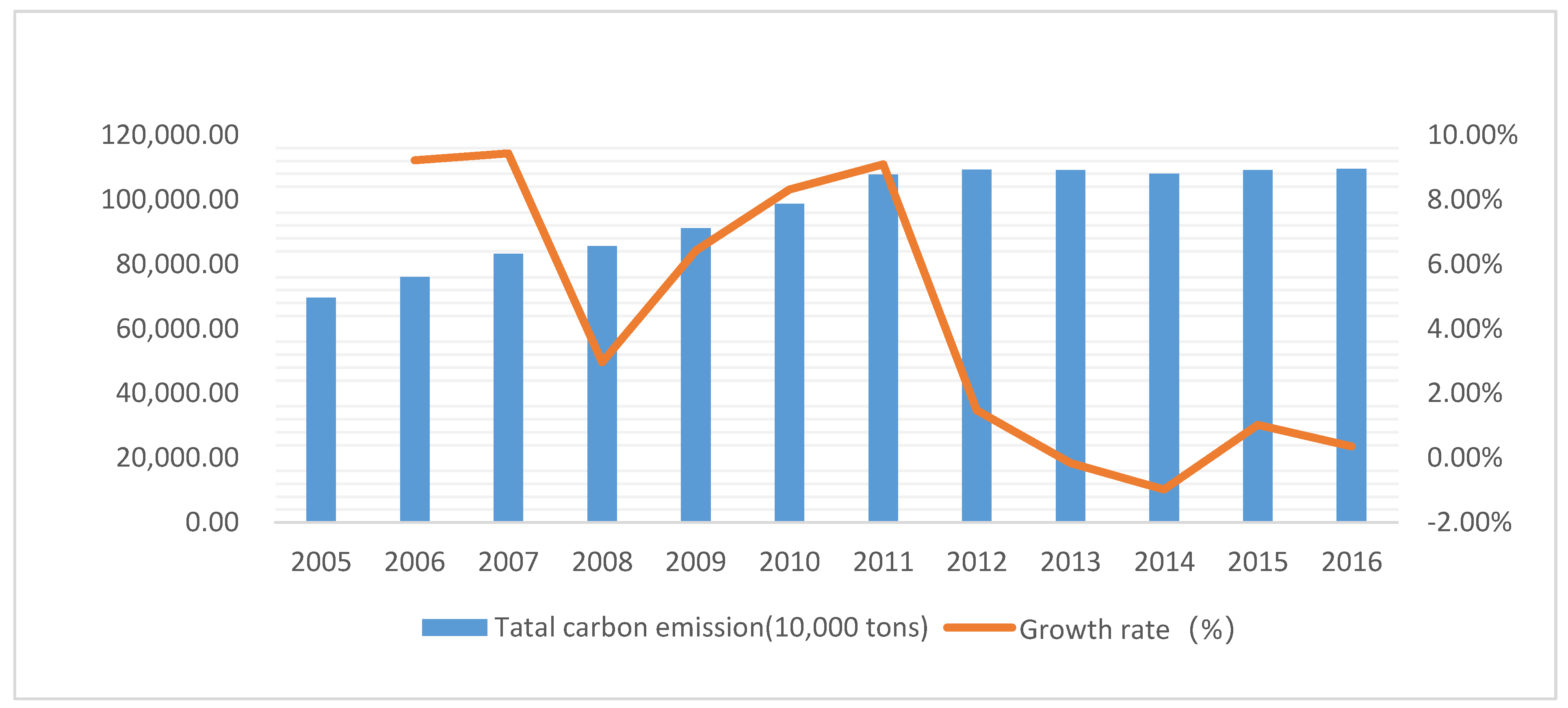
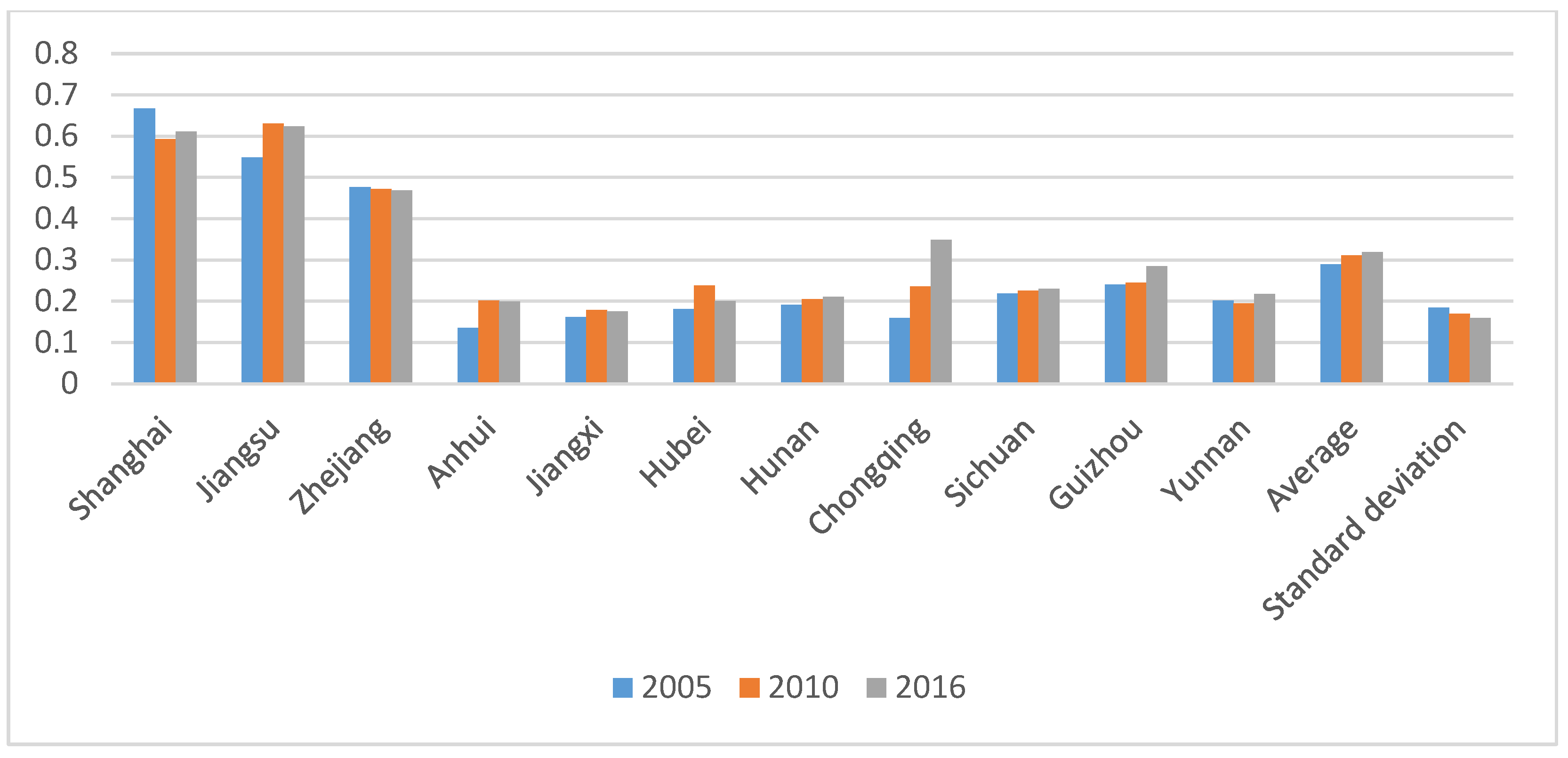
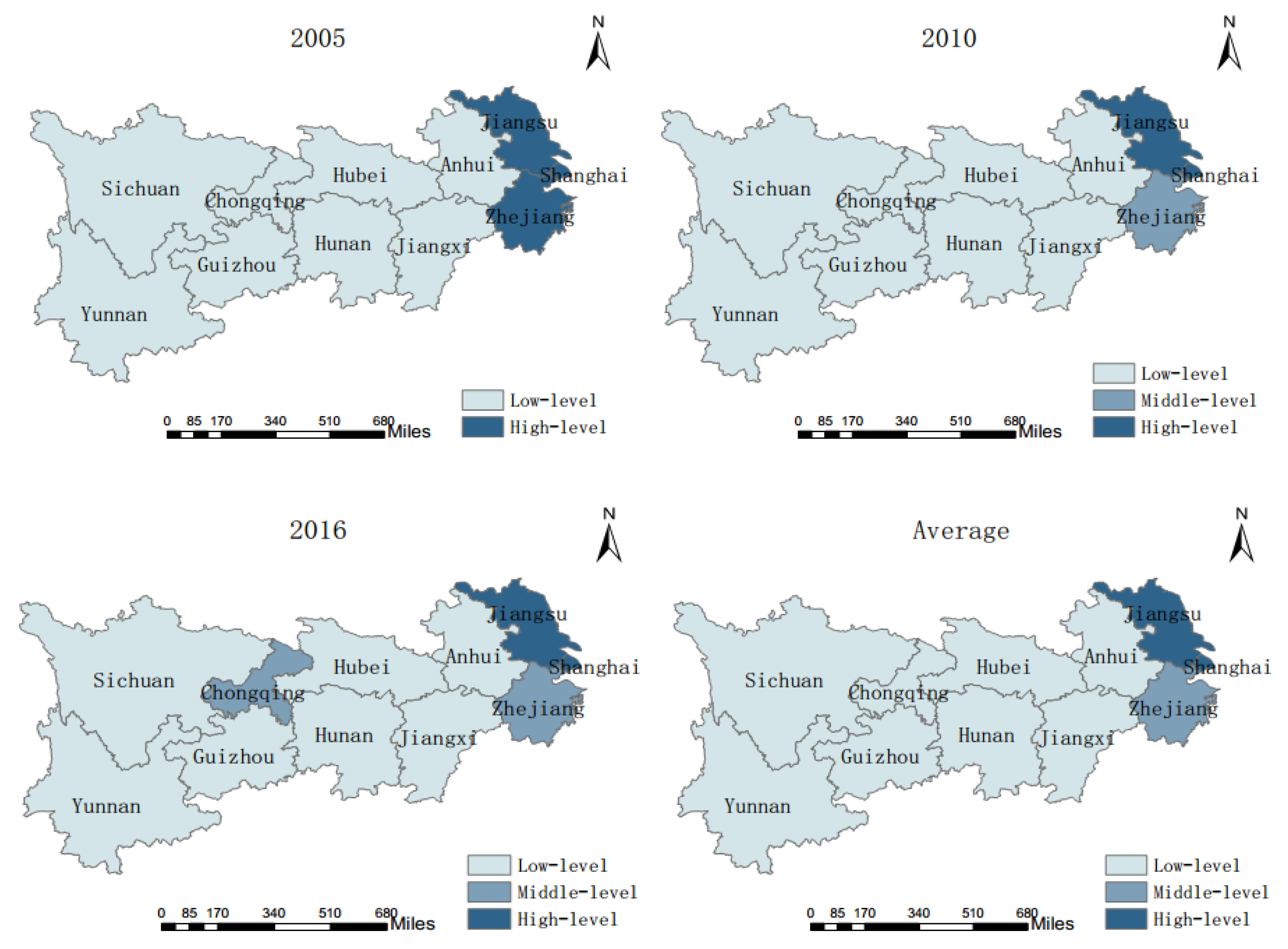
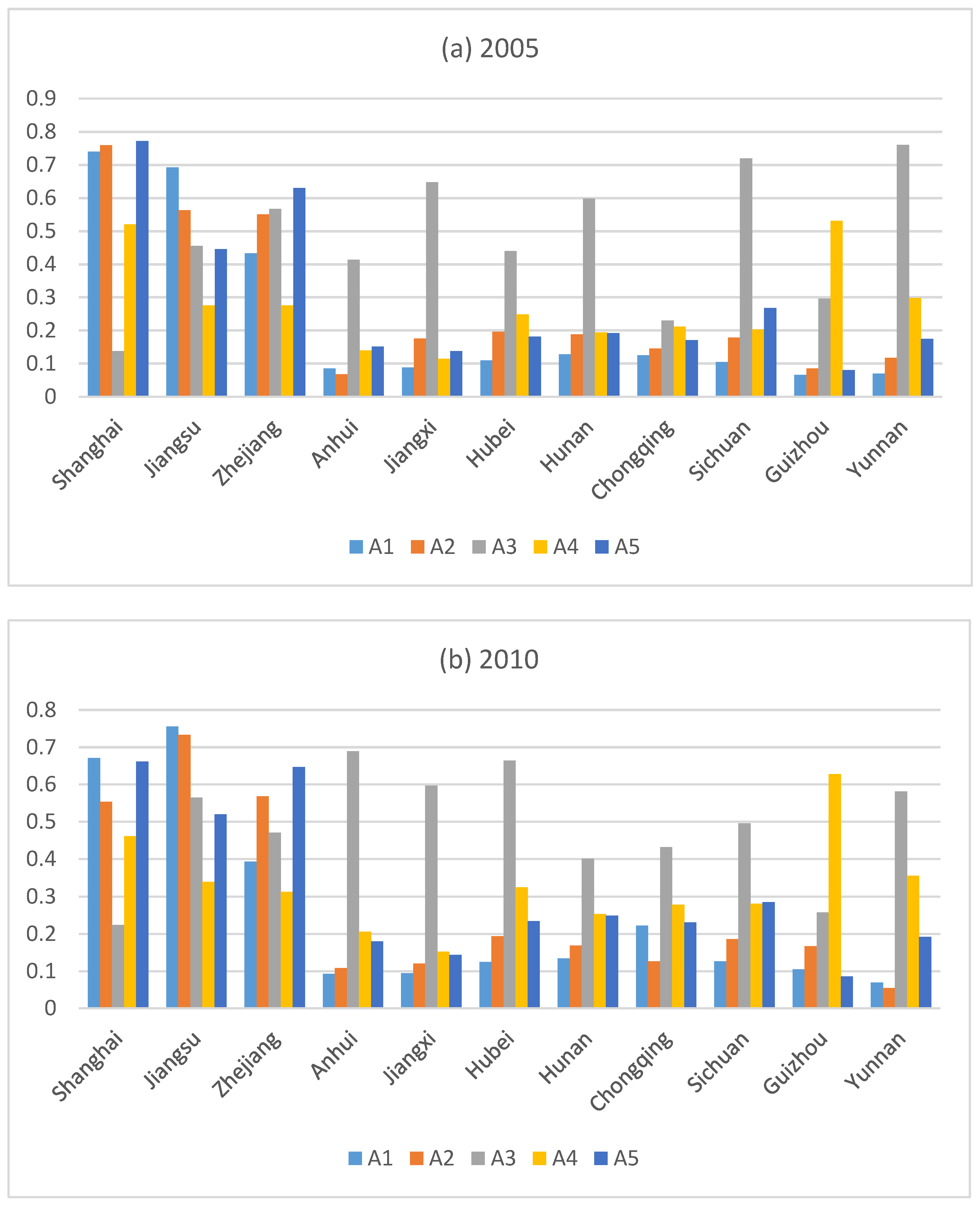
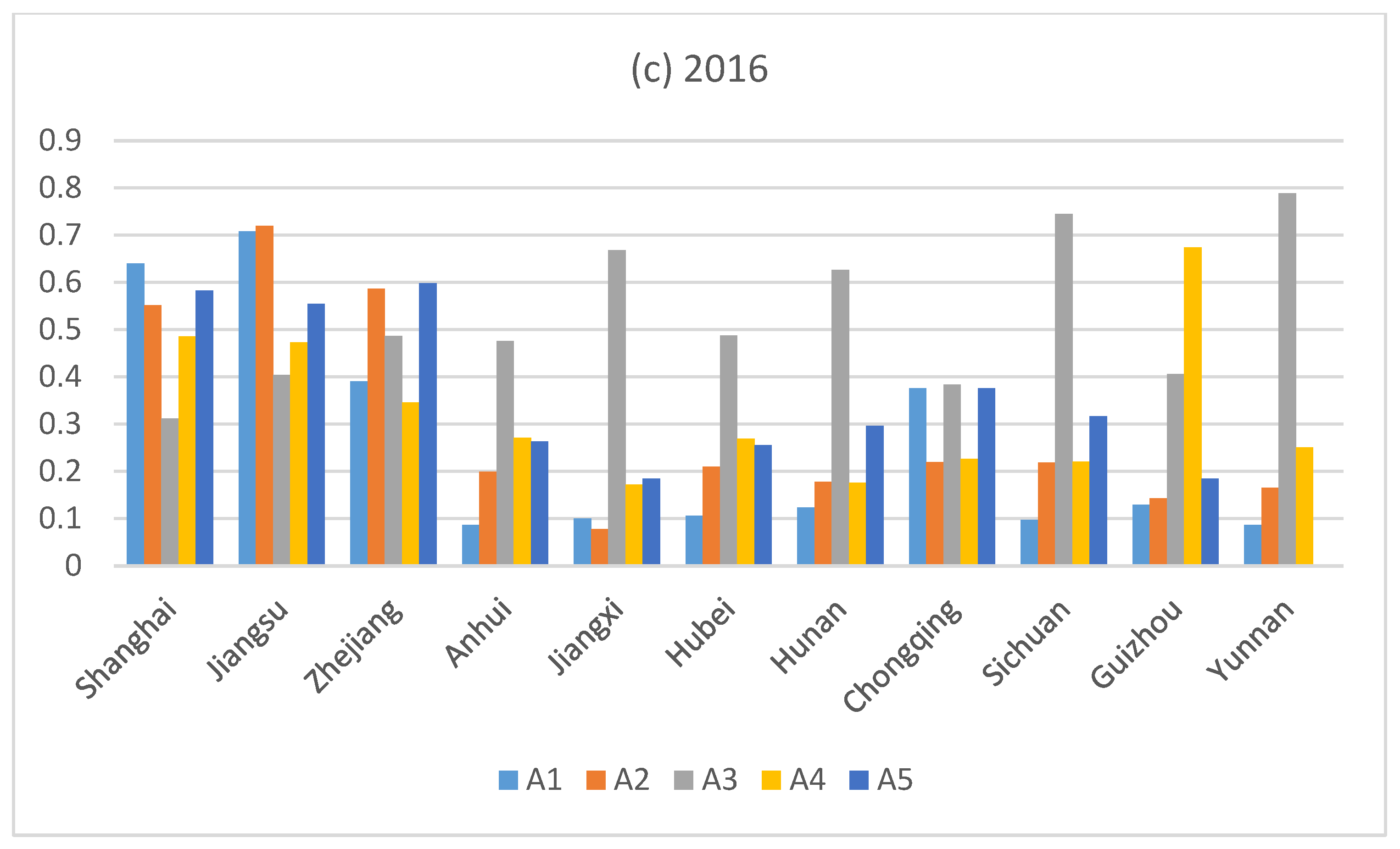
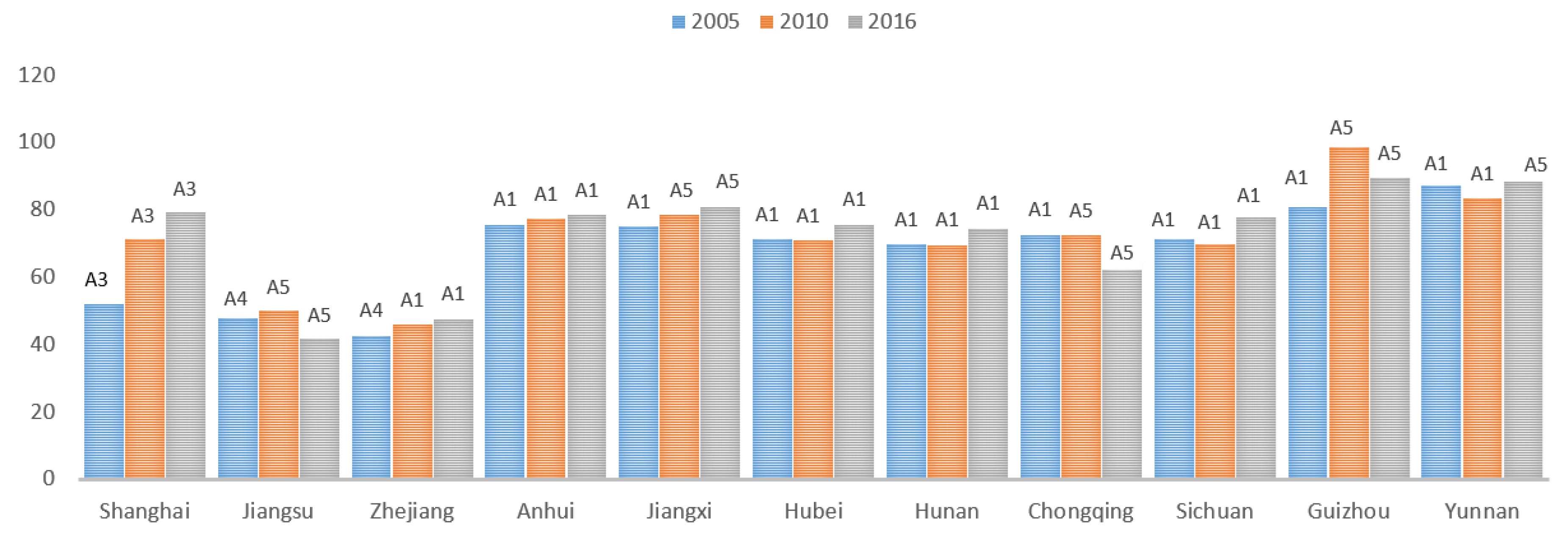
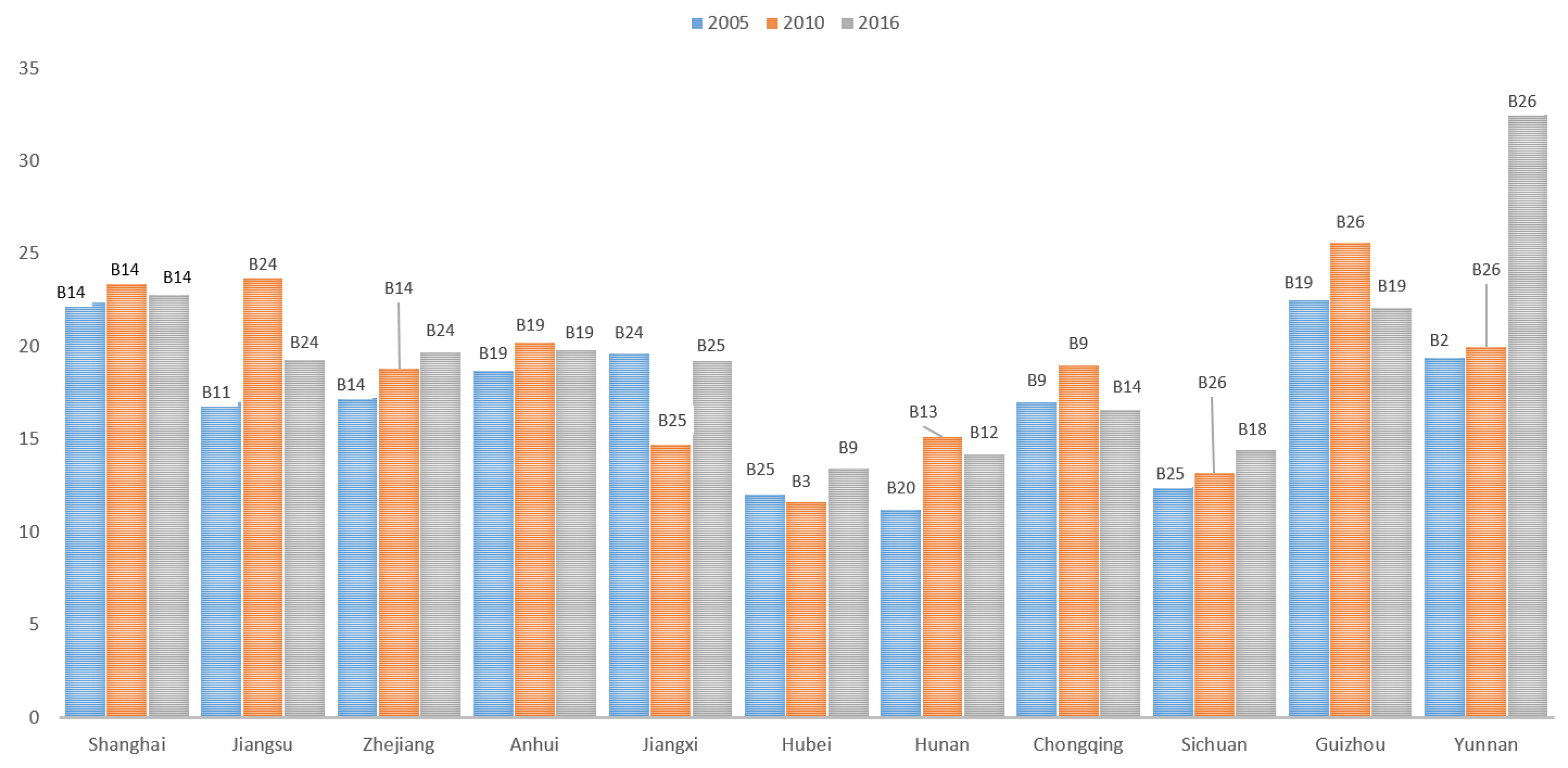
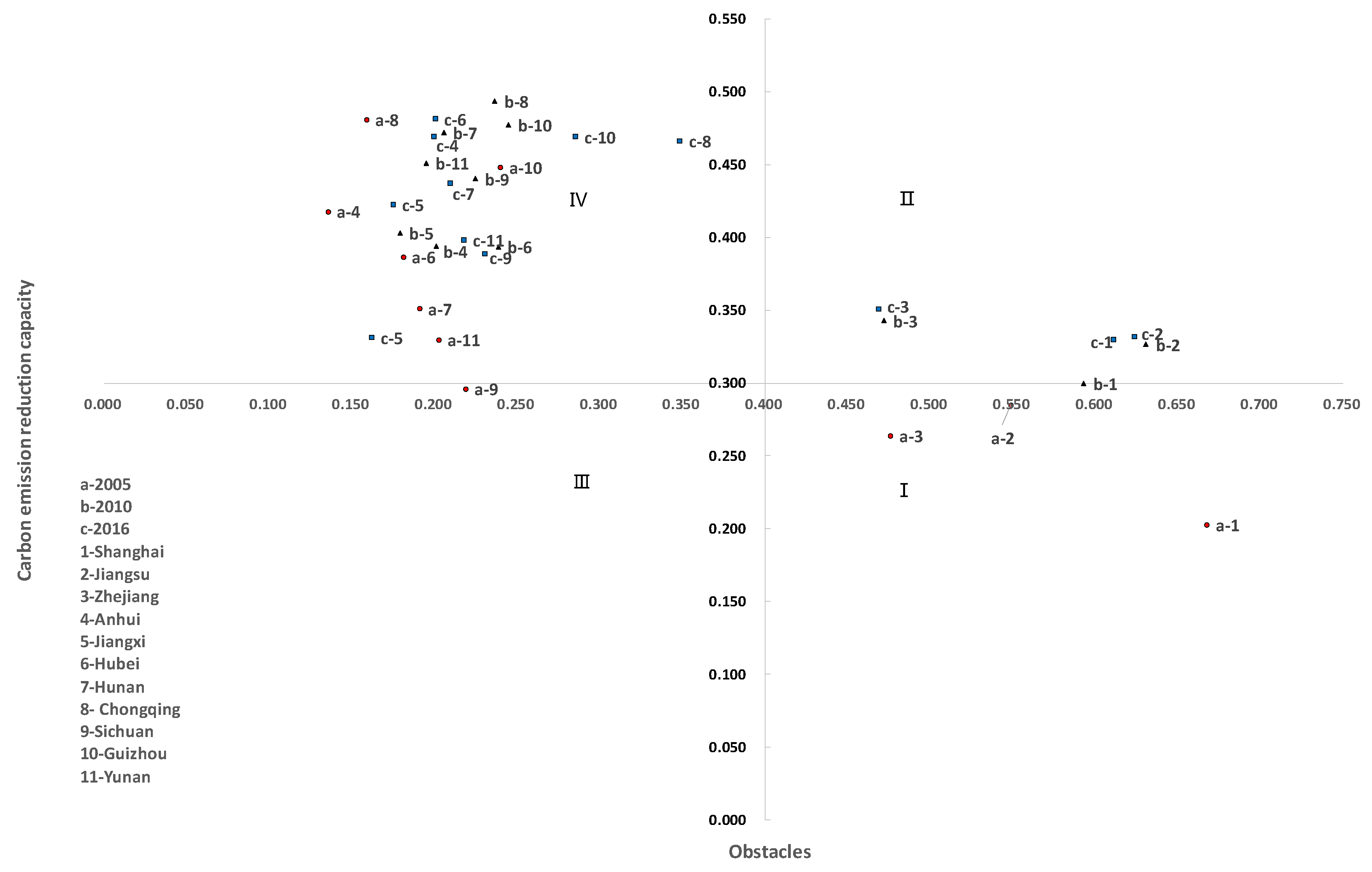
| Comment Content | Subsystem | Reference |
|---|---|---|
| emission reduction capacity | Industry and energy consumption structure Open to the outside world Technology and carbon sinks Energy consumption and carbon emissions Economic development | Yao et al. (2012) [13] |
| emission reduction potential | Carbon responsibility (Economic and social development, Energy and carbon efficiency) Carbon reduction capacity (Economic, technological, and carbon sink strength) Difficulties in carbon reduction | Wu et al. (2011) [14] |
| Low-carbon economy | Economic development and social progress Energy structure and usage efficiency Living consumption Development surroundings | Su et al. (2012) [8] |
| Low-carbon economy | Economy development social development Environmental assessment Science | Guo et al. (2017) [11] |
| Primary Indicator | Secondary Indicators | Unit | Attributes | ||
|---|---|---|---|---|---|
| A1 | Economic development | B1 | Gross domestic product divided by population | RMB | Positive |
| B2 | Gross domestic product growth rate | % | Positive | ||
| B3 | Urban per capita disposable income | RMB/year | Positive | ||
| B4 | Rural per capita net income | RMB/year | Positive | ||
| B5 | Fixed asset investment in the whole society | 108 RMB | Positive | ||
| B6 | Total import and export of goods by foreign-invested enterprises | 104 dollars | Positive | ||
| B7 | The tertiary industry accounts for the proportion of gross domestic product | % | Positive | ||
| A2 | Science and technology | B8 | Domestic patent grants | piece | Positive |
| B9 | Product quality | % | Positive | ||
| B10 | Technical market turnover | 104 RMB | Positive | ||
| A3 | Carbon sink | B11 | Forest cover rate | % | Positive |
| B12 | Per capita park green area | m2 | Positive | ||
| B13 | Forest carbon uptake | 104 tons | Positive | ||
| B14 | Crop carbon uptake | 104 tons | Positive | ||
| A4 | Energy consumption and carbon emission | B15 | Energy intensity | tce/10,000 RMB | Positive |
| B16 | Carbon intensity | ton/10,000 RMB | Positive | ||
| B17 | Energy footprint | tce/person | Positive | ||
| B18 | Carbon Footprint | ton/person | Positive | ||
| B19 | Coal consumption as a share of energy consumption | % | Negative | ||
| B5 | Social development | B20 | Civil vehicle ownership | 104 cars | Positive |
| B21 | Urbanization rate | % | Positive | ||
| B22 | Urban residents’ consumption level | RMB/person/year | Positive | ||
| B23 | Rural residents’ consumption level | RMB/person/year | Positive | ||
| B24 | Teacher–student ratio in ordinary universities | Number of teachers = 1 | Positive | ||
| B25 | Public transport vehicles per 10,000 people | Standard car | Positive | ||
| B26 | City gas penetration rate | % | Positive |
© 2020 by the authors. Licensee MDPI, Basel, Switzerland. This article is an open access article distributed under the terms and conditions of the Creative Commons Attribution (CC BY) license (http://creativecommons.org/licenses/by/4.0/).
Share and Cite
Tang, D.; Zhang, Y.; Bethel, B.J. A Comprehensive Evaluation of Carbon Emission Reduction Capability in the Yangtze River Economic Belt. Int. J. Environ. Res. Public Health 2020, 17, 545. https://doi.org/10.3390/ijerph17020545
Tang D, Zhang Y, Bethel BJ. A Comprehensive Evaluation of Carbon Emission Reduction Capability in the Yangtze River Economic Belt. International Journal of Environmental Research and Public Health. 2020; 17(2):545. https://doi.org/10.3390/ijerph17020545
Chicago/Turabian StyleTang, Decai, Yan Zhang, and Brandon J Bethel. 2020. "A Comprehensive Evaluation of Carbon Emission Reduction Capability in the Yangtze River Economic Belt" International Journal of Environmental Research and Public Health 17, no. 2: 545. https://doi.org/10.3390/ijerph17020545
APA StyleTang, D., Zhang, Y., & Bethel, B. J. (2020). A Comprehensive Evaluation of Carbon Emission Reduction Capability in the Yangtze River Economic Belt. International Journal of Environmental Research and Public Health, 17(2), 545. https://doi.org/10.3390/ijerph17020545





